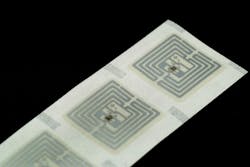RFID Market to Grow 10% in 2025
The RFID industry is expected to maintain its upward trajectory, with IDTechEx forecasting the passive RFID market to reach a total value of $8.4 billion in 2025, representing growth of approximately 10% compared to 2024.
This market value reflects passive RFID tags across all major form factors, including labels, cards, fobs, and secure documents, and highlights the distinction between the two dominant frequency segments: Ultra High Frequency (UHF) and High Frequency (HF).
While UHF tags will account for more than 88% of total shipments, HF tags will dominate in terms of revenue, making up around 60% of total market value due to higher tag pricing in secure applications.
UHF RFID Market Analysis
The UHF RFID market continues to be driven primarily by the retail apparel sector, which represents approximately two-thirds of UHF tag volume and over half of total market value.
By 2025, IDTechEx forecasts that nearly 32 billion RFID labels will be deployed in apparel tagging. Despite this scale, apparel tagging currently represents only about 40% of the total addressable market, indicating considerable potential for expansion.
Several factors underpin this success:
- Proven return on investment (ROI): RFID enables accurate stock monitoring, reduces lost sales, and enhances customer service through better product availability.
- Mature ecosystem: A well-established network of hardware, software, and systems integrators supports large-scale deployment.
- Falling tag costs: Continued price reduction and simpler infrastructure compared with NFC have lowered adoption barriers.
However, UHF reader infrastructure remains an area for development. Today, readers are largely business-focused tools, and UHF-capable consumer smartphones are not yet widely available. However, this may change over the next several years, following the adoption path of NFC in consumer electronics.
Markets Beyond Apparel
While apparel remains the anchor segment for UHF, other industries are accelerating adoption.
- Supply chain and logistics is now the second-largest UHF application, accounting for roughly 15% of total tag volume and 25% of market value. Digitalization initiatives, increased demand for real-time tracking, and lighthouse projects demonstrating operational efficiencies are driving uptake.
- Other retail categories such as electronics, home goods, and appliances are also expanding, helped by large-scale mandates from retailers like Walmart, which have been pivotal in pushing RFID beyond fashion.
These combined drivers, such as digital transformation, cost reductions, and mature technology ecosystems, are expected to support steady UHF market growth well beyond 2025.
HF RFID Market Analysis
While UHF leads in shipment volume, HF RFID dominates in value due to its role in secure, high-priced applications. In 2025, IDTechEx forecasts the sale of approximately 5.3 billion HF tags, representing an estimated $5 billion in market value. The average selling price of HF tags remains significantly higher than that of UHF, driven by applications where security and reliability are essential.
- Payments and access control remain the largest market for HF tags. Contactless cards and fobs continue to ship in high volumes but face long-term challenges as mobile payments, QR codes, and digital wallets gain traction.
- Passports and secure identification form the second-largest HF segment by value. While total volumes are smaller, the high pricing of secure HF inlays keeps the market sizeable.
Emerging NFC Applications and Smart Packaging
NFC (a subset of HF technology) continues to see growth in areas beyond payments, such as Bluetooth pairing, gaming, promotional engagement, and smart packaging.
Smart packaging represents the largest untapped volume opportunity, with the potential to exceed 1 billion units annually. However, large-scale deployment remains constrained by cost: industry feedback suggests that NFC labels must reach below 1 US cent to achieve mass adoption.
A promising development is the introduction of flexible integrated circuits (ICs). In 2025, Pragmatic launched the first commercial NFC-compatible flexible ICs, which could help reduce pricing and expand NFC use in packaging. But until proven use cases and lower costs come together, growth there will likely remain slow at first.
Summary
Overall, the RFID market in 2025 is shaped by two clear dynamics: UHF tags dominate by volume, driven largely by apparel and expanding into supply chain and broader retail, while HF tags capture most of the market value through secure applications like payments, access control, and passports.
UHF adoption is fueled by falling tag prices, a proven ROI in retail, and the prospect of smartphone compatibility, while HF faces long-term pressure from mobile-first payment solutions. Emerging NFC applications, such as smart packaging, could open new opportunities if costs come down and compelling use cases emerge.
